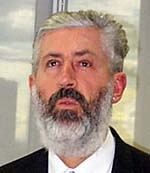Launch of Accessible events -- a guide for organisers (2006)
Launch of Accessible events -- a guide for organisers
|
Gold Coast Convention Centre |
 |
Acknowledgements
- Annabel Davis, President of MEA
- Suzie Jones, Chair of the Conference organising Committee
- Linda Gaunt CEO of MEA
- MEA members
- Ladies and Gentlemen
Introduction
Allow me to begin by acknowledging the traditional owners of the land on which we meet.
Well what a tough gig to get - a conference of conference organisers.
As you can imagine, I attend many conferences, and events such as awards ceremonies and workshops. I, and many other people with a disability, regularly experience the frustration and disappointment of arriving at a venue only to find there are steps at the entrance, or to find that you cannot hear the speakers, or to have no access to the handouts because they are only available in print.
Sometimes, however, the frustration is tempered by amusement. Some years ago I was attending a conference in a hotel where the lifts had no tactile or Braille information on the buttons to tell me what floor I was heading for. As I got into the lift with my guide dog another passenger joined me.
"Could you press ground, please," I asked. There was no response.
I repeated my request with the same result.
Thinking my fellow-traveller may have a hearing impairment, I turned to face him, and spoke loudly and clearly so that- if he couldn't hear me - he could read my lips.
"Oh!" he said "I thought you were talking to the guide dog."
Fortunately, most lift passengers don't share this inflated view of my dog's capacity- it's good, but it hasn't learned to read lift buttons yet! And fortunately also, most of the time I find that those organising events are eager to learn what they can do to ensure good access is provided.
I'm particularly pleased therefore to participate in this launch of a new guide, aimed at assisting events organisers to make their events more accessible to people with disabilities. It's the first opportunity I have had since my appointment as Australia's Human Rights and Disability Discrimination Commissioner in December to see the completion of a collaborative project between the Commission and an industry body.
Such collaboration is the most effective way of industry achieving a better understanding of its responsibilities under anti-discrimination law, and of producing a practical resource that will actually assist people to meet those responsibilities.
This project has been a very good example of how an industry body, such as Meetings Events Australia, can take the initiative. It provides its members with information that both assists them to improve access to a market which is often overlooked, and address legal liabilities in a practical way.
Why make events accessible
As the introduction to the guide says, there are many sound business reasons for thinking about access.
First, there are around four million people with disabilities in Australia, representing a considerable proportion of your potential audience or customers.
Second, people with disabilities also influence the choices of their families and friends to attend or not attend events, if they have had a previous bad experience.
Third, everyone benefits when access is better, including other attendees, people making deliveries, people with heavy baggage, young children, those with prams and many older people.
Finally, you have a legal responsibility to prevent discrimination against people with disabilities. Complaints of discrimination could result in costly court proceedings and rulings.
The guide itself looks at all aspects of the planning and running of events: from choosing a venue; to ensuring booking procedures are accessible; to use of audio visual material; to catering.
Rather than provide checklists of technical requirements, the guide provides tips on how to improve access, and how to get more technical information when required.
As a web based resource, MEA will be able to easily update the material, and add new information based on the experience of those who use it.
Why Innovation and change?
I note that the theme of this conference is innovation, and that one of your objectives is:
"To be an agent of change, because the industry is rapidly changing, and delegates want information on how to deal with this change".
This guide sits very comfortably with this objective, as it informs you about how to deal with the changes required to open up events to all Australian's.
Congratulations
So, Congratulations: I congratulate your CEO, Linda Gaunt, for supporting this project, and Peter May for his early input. But most of all, I thank one of MEA's Directors, Ruth Lilian, who provided the greatest assistance in the drafting of the guide.
I am pleased to symbolically press the button to launch the guide. I'm sure you'll be more perceptive about it than my colleague who didn't press the button in the lift. I urge you to download a copy from either the MEA or Commission website, and provide feedback on how useful it is.
Thank you.
